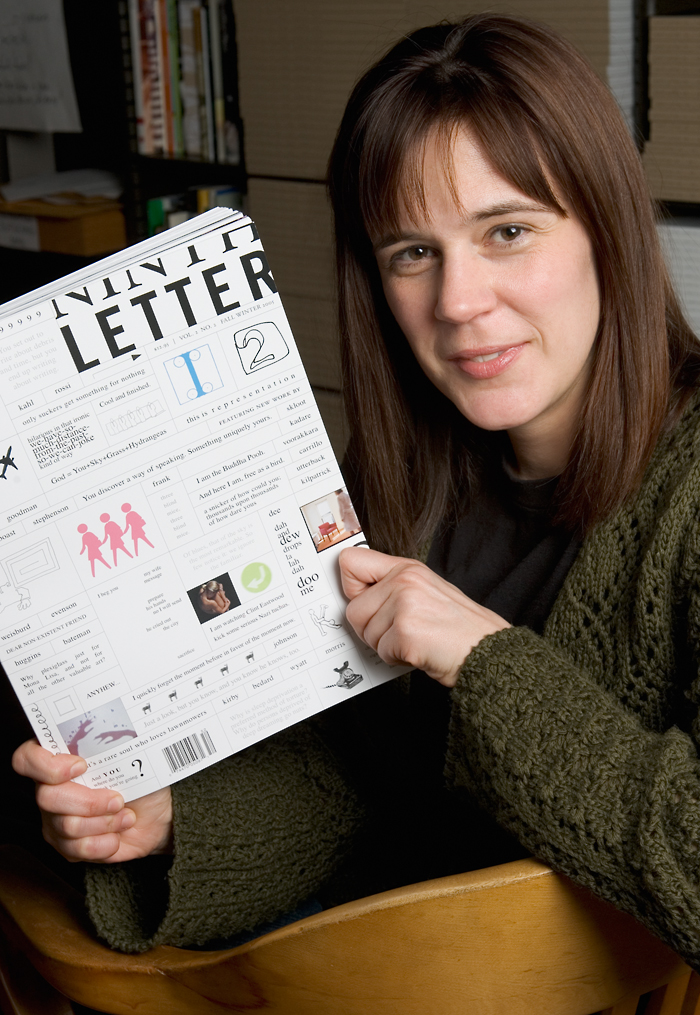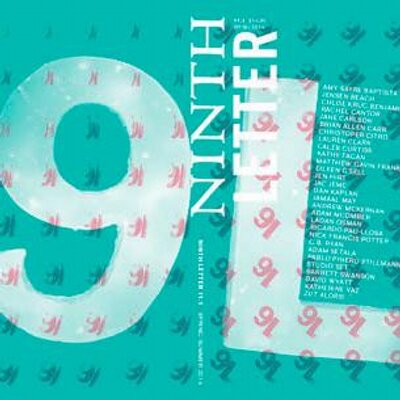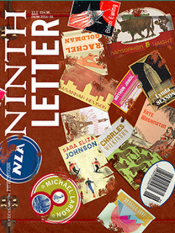You have /5 articles left.
Sign up for a free account or log in.
 Jodee Stanley is Editor of Ninth Letter at the University of Illinois, Urbana-Champaign, and Director of the Creative Writing Program. She has worked in literary publishing for more than twenty years and has been a speaker and panelist at various conferences and festivals, including Bread Loaf, AWP, MLA, and the Kenyon Review Literary Festival. In 2009, she was awarded an Academic Professional Award from the College of Liberal Arts and Sciences at UIUC, and she received a 2007 Faculty Fellowship from the University of Illinois Academy for Entrepreneurial Leadership. Her fiction, essays, and book reviews have appeared in journals such as Mississippi Review, Crab Orchard Review, 580 Split, Cincinnati Review, Future Fire, BkMk Quarterly, The Smoking Poet, Sycamore Review, Sou'wester, and Electric Velocipede, and have received special mention in the 2004 Year's Best Fantasy and Horror and the 2001 Pushcart Prize anthologies.
Jodee Stanley is Editor of Ninth Letter at the University of Illinois, Urbana-Champaign, and Director of the Creative Writing Program. She has worked in literary publishing for more than twenty years and has been a speaker and panelist at various conferences and festivals, including Bread Loaf, AWP, MLA, and the Kenyon Review Literary Festival. In 2009, she was awarded an Academic Professional Award from the College of Liberal Arts and Sciences at UIUC, and she received a 2007 Faculty Fellowship from the University of Illinois Academy for Entrepreneurial Leadership. Her fiction, essays, and book reviews have appeared in journals such as Mississippi Review, Crab Orchard Review, 580 Split, Cincinnati Review, Future Fire, BkMk Quarterly, The Smoking Poet, Sycamore Review, Sou'wester, and Electric Velocipede, and have received special mention in the 2004 Year's Best Fantasy and Horror and the 2001 Pushcart Prize anthologies.
This interview took place in October and December 2015, by Skype with a grad seminar in literary publishing at McNeese State University, and by email. Participants included Avee Chaudhuri, Meghan Giles, Brett Hanley, Lauren Howton, Dustin Shattuck, and John Griswold.
***
BH:
Ninth Letter’s design really stands out. What’s the process from conception to end product?
Jodee:
I wish I could take credit for that, but we collaborate with the Graphic Design Department at Illinois, and they have a course dedicated to the design of Ninth Letter. So we’ll do the editorial work for an issue here [in the English Department], and that will take a semester, and then at the beginning of the following semester we give all our material to the design class for that semester. They have a chance to read through it, and we go over there as a group to talk to them about our selection process. They ask questions about why we may have chosen certain things, or how things might fit together for us in an editorial fashion, and then we just let the graphic designers run with it.
I think the way they work in that class is that the faculty member, acting as an Art Director, talks with the students, and they decide an overall theme or direction. He or she will head that up but let the students go with it. The Art Director we’re working with now does all the actual text layout but lets the students work on the visuals.
And of course I give them a budget. So if they want to do 3-D glasses, or a slipcover, something fancy like that, they have to make sure it fits within the budget. It works really well, especially for the design students, in learning how to be creative and think outside the box with a certain amount of money.
The only other restrictions I have for them are that nothing can interrupt the integrity of the work, nothing can disrupt the reading of it. We don’t want poems to look weird on the page, or stories to be split up so they can’t be read sequentially. And things need to be legible, which we’ve had problems with in the past. Things have to be able to be physically be read without interruption of the text. So those are my only two stipulations: You have to be able to read it. You can’t interrupt the integrity of the text. Otherwise, they’re free to do whatever they want. And it works out pretty well, for the most part.
MG:
Although there are rotating staff members [ie, students] who choose content and shape design, the journal has a strong identity, both in print and online. How do you maintain that identity?
Jodee:
Even though many things change with every issue, there are certain components of Ninth Letter that appear consistently, and people know to expect those things—I think that helps to solidify our identity. For example, we have a regular feature appearing in each issue called “Where We’re At,” that features short essays on topics related to the Midwest, or sometimes includes interviews with Midwestern writers and artists. It’s important to us to maintain a strong and obvious connection to our region, even though we’re not an entirely regional journal in terms of content. We also always include art and/or design features, and each issue of the journal, no matter how different they look individually, is always very visually dynamic. That’s something people have come to expect from us, and is a big part of our identity.
AC:
Who are you reading, in terms of other journals? Who do you admire, and what do you try to emulate?
Jodee:
We’re too busy trying to maintain self-consistency to worry much about what other journals are doing, in terms of emulation. I mean, there are certainly journals I would love to work on. One of my favorites, and has been since they started, around the same time we did, is One Story. They’re the polar opposite of Ninth Letter. They just publish one story every three weeks, in an adorable no-frills booklet, which I think is brilliant. The quality of their fiction is always high, and I love that they never repeat an author, so you essentially can only be published in One Story once, and that’s it, which forces them to always be on the lookout for new authors and new talent. They can’t be like, “Well, we don’t really like anything in the slush pile, so we’ll just get in touch with Steve Almond again, or Kelly [Link], or somebody they’ve published and love. So they always have to be on top of it and looking for new work.
I like the Cincinnati Review. I’ve known the editors a long time, even when they worked at other journals, and I’ve always admire their tastes and how we share similar aesthetics, and I like to read what they publish. Not oddly, I see a lot of writers we’ve published end up on their pages, and vice versa. But there are a ton of good journals out there. Whatever you’re interested in, you can find somebody out there interested in the same thing. What are some journals you guys like?
AC:
Cimarron Review, at Oklahoma State. Bat City Review, over in Austin.
Jodee:
Yeah, they’re great.
AC:
And I have to rep Louisiana: The Southern Review at LSU.
Jodee:
Yes, Southern Review. They’ve been great for a long time. The people who are at Cincinnati Review now, Nicola Mason and Michael Griffith, were grad students at LSU and worked on The Southern Review. That’s actually how I first got to know them. I was working at another journal, they were working at Southern Review, and we got to know each other professionally. But Southern has had a very strong, long life. I think they do really good work.
JG:
Hey, Jodee, how does your online content work, editorially? Do you have separate staffs for online and print, or do you just make a decision that this is going here and this is going there?
Jodee:
We have two portions of our website devoted to original content. We have regular online features, and there’s no real submission process for those, no set schedule. If I, or one of our faculty editors, find something interesting out in the world and don’t think it would necessarily work in print, maybe for formatting reasons, we can put it in that space. Or we’ll meet an author who’s got a book coming out very soon, and we can publish an excerpt to help promote it. Everyone on staff is welcome to throw stuff at me and say, “This would be cool for the website,” and usually I’m like, “Yeah, let’s do that.”
But for about three years we’ve also published two online-specific editions a year. We have an entirely separate staff that reads submissions, affiliated with an undergraduate publishing class we do here. So we have juniors and seniors in creative writing who can take the Ninth Letter publishing class, and they work just like the staff of the print journal: They take submissions. They read through them. They make their selections. They have a faculty editor who oversees the class. And, when those selections are made, they’re published online as an issue; the whole thing goes up at once.
Up until this semester we’d been featuring student writing in those issues, submissions restricted to people enrolled in a creative writing program, either undergraduate or graduate. We did that for three or four issues then decided we wanted to change things up. This semester, the staff is reading for a Midwest Authors issue, restricted to people native to or currently living in the Midwest.
For me it’s interesting, because we have two entirely separate submission protocols, two entirely separate staffs making selections, both very focused on quality, but the aesthetics out of that undergrad class are a little different from the current print journal staff. It gives us an opportunity to be a platform for that many more writers and to showcase that many more aesthetics.
LH:
How’d you get your start in the field?
Jodee:
That’s so long ago! In 1992, I was a senior at the University of Missouri, which is where the Missouri Review is. I didn’t know literary journals were a thing that existed. I had never heard of them. I was taking a fiction workshop with the editor, and he asked me if I would want to be an intern on the journal. And I was so flattered because my professor had asked me, like, specifically, if I wanted to do this separate thing, and I was like, “Yes, I would be happy to.” I had no idea what he was talking about, frankly, but I was like, “Okay, sounds cool.”
I joined the staff, and suddenly I realized this is what you could do as a writer. Up to that point, the only short stories I was reading were in the Norton anthology, or in other anthologies on the shelves in the library, and I didn’t know there was a whole field of publication that was dedicated to publishing contemporary poetry and short stories. It was eye-opening. So, when I decided to get an MFA after undergrad, I looked specifically at programs that were at schools with journals. I ended up going to Emerson College and working at Ploughshares, and once I graduated from there, I kept working at Ploughshares for a while on a part-time basis, until I ended up getting another job at another journal. I got really lucky. It is not easy to make a career in literary publishing, but I managed to sort of stick it out in the early days and lucked into a full-time job eventually, and ended up here, doing this. So I haven’t done anything else, except, you know, in college, waiting tables and stuff like that. Otherwise, I’ve been doing publishing my whole life.
JG:
Along those lines, Jodee, I think of you guys, or the Georgia Review, places that are funded, have actual staffs, and are generally able to have a journal as its own thing. How many of those situations are there in the country? What’s the word on the editorial street about how that’s going?
Jodee:
It’s not going well. I think you probably know. There are certainly fewer journals like this that are funded and have their own staffs than there used to be. But there are a few. Southern Review has a dedicated staff. Cincinnati Review has at least a dedicated staff member. Their managing editor is a part-time staff position. Georgia, Gettysburg, though I’m not entirely sure what’s going on with them right now. They’ve been there a long time. The New England Review, which is where I was before I was here, at Middlebury College. They have a dedicated staff.
I mean, in most situations what you’ll have is something like what you’re doing at McNeese, a faculty member overseeing it and students working on it. I think that’s the primary way things are working at university journals. Either completely student-run journals like the Indiana Review or Black Warrior, or faculty-edited, student-assisted journals. And I’m really the only dedicated staff member here. Everyone else who works with me is a faculty member or a graduate student or an undergraduate student.
For the most part, I think if universities are at all willing to fund new journals, the work is added on to faculty’s job descriptions, or they’re getting students involved as much as possible. As long as you have people who are willing to put the effort in, and who are dedicated to it, you can make something good happen.
BH:
What’s your favorite issue of Ninth Letter?
 Jodee:
Jodee:
There’s something I love in every issue, and there are some issues I like more, design-wise, than others, but my favorite overall is Volume 11, Number 1. You know why? Because I was the fiction editor for it. If we don’t have a faculty member who’s free or willing to step up in a certain semester for one of the genres, I’ll step in. Right now I’m editing nonfiction. But in that issue, I was editing fiction. We’d gotten to the end of the semester and had selected only two stories, and I had about a month before I had to get everything copyedited and handed over to the design team. So I said, “If you guys want to keep reading over winter break, you can. Otherwise, I’ll just keep going to pick the rest of the stories for this issue.” So I ended up having a lot of say…I actually got to select pieces that I really, really felt close to. Usually I like for everyone to feel as if they’re close to something in an issue, so I’ll give up some of my favorites in order that our students are able to get some of their favorites. For that issue, none of the students had any favorites, and I was like, “Fine, I’ll just put in my favorites,” and I felt really good about that issue. And I really liked the design of it. It was the first time we’d done a different size [format] in a while, and I thought that was really fun. I also loved the design of an issue that had an airline theme.
Yeah: the airline one was bigger than normal, and the one with my chosen fiction was smaller than normal. Now we’re going back to the normal-normal size, so we’ll see what happens. I mean, I’ll admit, we’ve certainty had some design fails in the past. We don’t get a lot of negative feedback, but when something is really working, we get a lot of positive feedback. For me, I think that’s the great thing about the Internet. If it weren’t for people being able to get onto Facebook and Twitter, and say, “Oh my god, the new issue of Ninth Letter, have you seen it? It has 3-D glasses, it’s so cool,” I would never know, necessarily, but now that we have this ability to be communicating with each other all the time, I can see people responding. It’s really great.
DS:
In addition to being the editor of a major university lit journal, you serve as director of the creative writing program at Illinois. How do you make time for your own writing? And how does rotating all those hats shape your thinking about writing and publishing?
Jodee:
I don’t make enough time for my own writing, actually, and that’s been one of the few real downsides to an otherwise amazing career track. I love being involved with writing, literature, and publishing in any way possible, whether it’s editing, or managing a writing program to provide the best possible environment for new writers, or organizing events, or doing community outreach—it’s all satisfying for me creatively. But it doesn’t allow me the necessary space and energy to devote a lot of time to my own craft. One thing I have learned, though, is that the desire to write doesn’t go away—even if you find you have to back-burner ideas, or squeeze writing in here and there, the urge never leaves. The ideas always come. And, you know, someday I’ll retire. Then I can write all the stories.
***
The Fall/Winter issue of Ninth Letter is now available! Check it out.





